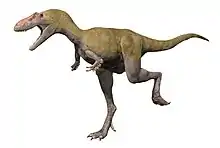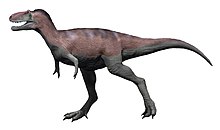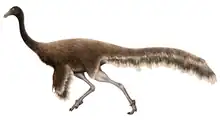Daspletosaurini
Daspletosaurini is an extinct clade of tyrannosaurine dinosaurs that lived in Laramidia during the Late Cretaceous (Middle Campanian) period. It consists of two genera: Daspletosaurus and Thanatotheristes. Four species have been described in the two genera, namely Daspletosaurus torosus, Daspletosaurus horneri, Daspletosaurus wilsoni, and Thanatotheristes degrootorum. At one point all of them were assigned as specimens of D. torosus, but several papers since 2017 have found them to represent distinct species. These studies found anagenesis in the group, whether contained in a daspletosaurin clade or paraphyletic in respect to the lineage of tyrannosaurines leading up to Tyrannosaurus.[1][2][3]
| Daspletosaurins Temporal range: Late Cretaceous, middle Campanian | |
|---|---|
 | |
| Skeletal mount of Daspletosaurus torosus | |
| Scientific classification | |
| Domain: | Eukaryota |
| Kingdom: | Animalia |
| Phylum: | Chordata |
| Clade: | Dinosauria |
| Clade: | Saurischia |
| Clade: | Theropoda |
| Family: | †Tyrannosauridae |
| Subfamily: | †Tyrannosaurinae |
| Clade: | †Daspletosaurini Voris et al., 2020 |
| Type species | |
| Daspletosaurus torosus Russell, 1970 | |
| Genera | |
Description

Daspletosaurins were large predators, reaching around 9 metres (30 ft) in length.[1] However, they were not the largest tyrannosaurids, as more derived taxa, such as Tyrannosaurus, could reach lengths of more than 12 metres (39 ft).[4]
Daspletosaurini is diagnosed by characteristics such as the presence of an extremely coarse subcutaneous surface of the maxilla anteroventral to the antorbital fossa; a constricted jugal ramus of maxilla; the anteroventral corner of the maxilla tapers into a shallow angle (<65°) as measured between the alveolar margin of the first two alveoli and the anterior margin of the subcutaneous surface; a prefrontal that is broad in dorsal view and strongly dorsomedially arced in anterior view; a dentary chin located ventral to either the third alveolus or third interdental plate and possessing no fewer than 14 maxillary teeth.[2]
Classification
In the 2020 description of Thanatotheristes, Voris et al. erected Daspletosaurini as a new clade within Tyrannosauridae, as a sister taxon to a clade comprising Zhuchengtyrannus, Tarbosaurus, and Tyrannosaurus. The cladogram below shows the results of the phylogenetic analyses performed by Voris et al. (2020):[2]
| Tyrannosauridae |
| ||||||||||||||||||||||||||||||||||||||||||||||||||||||||||||||||||||||||||||||||||||
In 2022, Warshaw & Fowler proposed that the three Daspletosaurus species evolved through anagenesis in the Tyrannosaurinae in a line leading to Zhuchengtyrannus, Tarbosaurus, and Tyrannosaurus. Due to their more fragmentary nature, Thanatotheristes and Nanuqsaurus were excluded from this analysis. The cladogram below shows the results of the phylogenetic analysis performed by Warshaw & Fowler (2022).[3]
| Tyrannosaurinae |
| ||||||||||||||||||||||||||||||||||||||||||||||||||||||||||||||||||
References
- Carr, Thomas D.; Varricchio, David J.; Sedlmayr, Jayc C.; Roberts, Eric M.; Moore, Jason R. (2017). "A new tyrannosaur with evidence for anagenesis and crocodile-like facial sensory system". Scientific Reports. 7: 44942. Bibcode:2017NatSR...744942C. doi:10.1038/srep44942. PMC 5372470. PMID 28358353.
- Voris, Jared T.; Therrien, Francois; Zelenitzky, Darla K.; Brown, Caleb M. (2020). "A new tyrannosaurine (Theropoda: Tyrannosauridae) from the Campanian Foremost Formation of Alberta, Canada, provides insight into the evolution and biogeography of tyrannosaurids". Cretaceous Research. 110: 104388. doi:10.1016/j.cretres.2020.104388. S2CID 213838772.
- Warshaw, Elías A.; Fowler, Denver W. (2022). "A transitional species of Daspletosaurus Russell, 1970 from the Judith River Formation of eastern Montana". PeerJ. 10. e14461. doi:10.7717/peerj.14461.
- Holtz, T. R. (2011). "Dinosaurs: The Most Complete, Up-to-Date Encyclopedia for Dinosaur Lovers of All Ages, Winter 2011 Appendix" (PDF). Retrieved January 13, 2012.



.jpg.webp)












